The chronospheres are psychic experiences and dynamic spacetime events, like concentric circles in the water, they are different frequencies of the passing of time that involve us; if spacetime is like the ocean, the circles in the water are the traces and the different times that unfold and dilate, mixing and overlapping continuously
di Alessandro Mazzi
originally published on The Indiscreet
cover: Kenny Callicutt, "Light From the Beginning of Time"
«The wheel of certain religions of Hindostan seems to me more reasonable; in this wheel, which has no beginning or end, each life is the effect of the previous one and generates the next, but none determines the whole ... "
Jorge Luis Borges, "The Aleph "
«You teach that there is a Great Year of becoming, a year beyond any great limit, which, like an hourglass, must always overturn, in order to flow and run out. "
Friedrich Nietzsche, "Thus spoke Zarathustra "
«We can return to immerse ourselves serenely in time, in our time that has ended, to savor the clear intensity of every fleeting and precious moment of this short circle. "
Carlo Rovelli, "The order of time "
The philosophy and literature of recent years have often devoted themselves to the hyperbolic and the disturbing. In the work Hyperobjects (2013) of Timothy Morton, for example, the author explains how all the objects we deal with are actually so vast and complex that they transcend our normal understanding. Without realizing it, some phenomena engulf us like whales: evolution, black holes, global warming - even spacetime, which surrounds us like flies dipped in honey. Hyperobjects are realities to which we are entangled and from which there is no escape, they put us in front of an experience with an oriental flavor: things are impermanent and interrelated, and although their impermanence upsets us, we cannot help but welcome it.
For Morton the world is something disorienting and dark, «Because no entity has a world or, as the philosopher G. Harman puts it, because 'there is no horizon'»; in the frenzied miasma of spacetime, there are no extended bodies, but everything constantly radiates space and time, like the turbulence of a current. The human subject is forced to carve out a small part of the whole, if he wants to give meaning to his own experience, but even then he will always be in constant interaction with all the other objects, confronted with the contingency of things. However, it is precisely in the possibility for man to find his own measure that the ability to draw boundaries is found.
In the trilogy balls (1998, 1999, 2004), to remedy the monstrous and disorienting abyss of the world, the German philosopher P. Sloterdijk traces the human psychic spaces through the archetype of the sphere. Being in the world for Sloterdijk always means being in a sphere, that is "the roundness with an interior, disclosed and shared" where men "create circular worlds and look outward, towards the horizon". It is the vital space that man produces to immunize himself from the outside, or as a symbolic protection for the space of our interiority. From the maternal womb to one's own homes, to the mandalas and the great cosmologies of myth and science, through the spheres we are always involved in an essential co-existence from the other entities with which we share space. However, Sloterdijk does not deal with the question of time, focusing almost exclusively on spatial extensions.
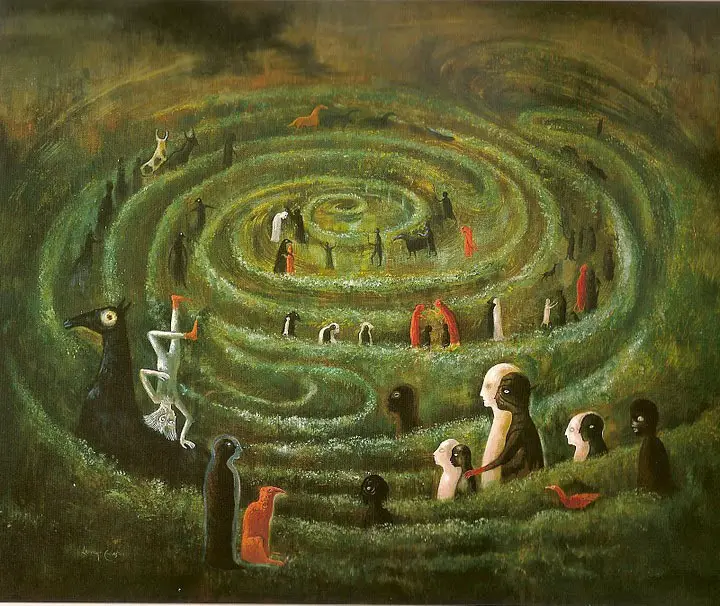
In Minimum Temporalia (2005) Marramao argues that it is possible to speak of time only through spatial images, criticizing the philosophies that conceive of a separate space and time. Resuming Baudelaire, Marameo asks:
«How could we, in fact, experience the events of our life if we did not place them, not only in memory or in prospecting for the future but also in the while they happen to us, within a scene? "
In the footsteps of Plato, who in Timaeus defines chronological time as the "moving image of eternity", and of Descartes, who in his Meditations remembers how talking about an idea is impossible without referring to a representation of it, Marramao encourages the measured use of circular temporal images, drawn from the ancient experience of eternal time:
«Our existence resembles the arcane law of that vortex, of that perpetual motion that holds the top upright at the point. "
This is why I would like to propose le chronospheres: these are psychic experiences and dynamic spacetime events, like concentric circles in the water. There are different frequencies of the passage of time that involve us. If spacetime is like the ocean, the circles in the water are the traces and the different times that unfold and dilate, mixing and overlapping continuously. We are always in chronospheres, like when we jog on the beach, tuning in to our watch but perceiving moments longer or shorter than the stopwatch, while a man sitting on the shore next to us contemplates the sea as he was listening to eternity.
From a strictly physical point of view, fundamental equations on cosmological scales, such as that of 1967 by Bryce DeWytt and John Wheeler, do not use the time variable, but describe how things and the facts of the world change with respect to each other. At such small scales, at the quantum level, there is no time. But this does not mean that we must abandon the world on a human scale. For Ernst Junger in its At the wall of time (1959) “It seems that cyclic systems are more in keeping with the spirit. For this reason the watches we build are generally round, although there is no logical constraint in this sense ". While we're not sure how time emerges from the frenzied void of quantum mechanics, the cycle and spiral are man's original spacetime psychological experiences. Jünger continues, «To explore man in the depths of him: this does not mean seeing qualities, it means seeing forms. They alone have the power to tame the titanic ».
The time of the myth: eternity and chronological images
“I saw eternity the other night
like a great ring of pure and infinite light,
as placid as it shone;
and round below, time in hours, days, years,
moved by the spheres ... "Henry Vaughan, "The World"
For the archaic human being, being in the world meant looking up and experiencing the cyclic motion of the celestial vault, from which the astronomer, "he who distributes the stars", drew the measure of the time of his environment, etymologically "what surrounds us". Plato in Timaeus remember:
“Now, the vision of the day and the night, of the months, of the periods of the years, of the equinoxes and of the solstices, has given us the number, the notion of time and the investigation of the nature of the universe. "
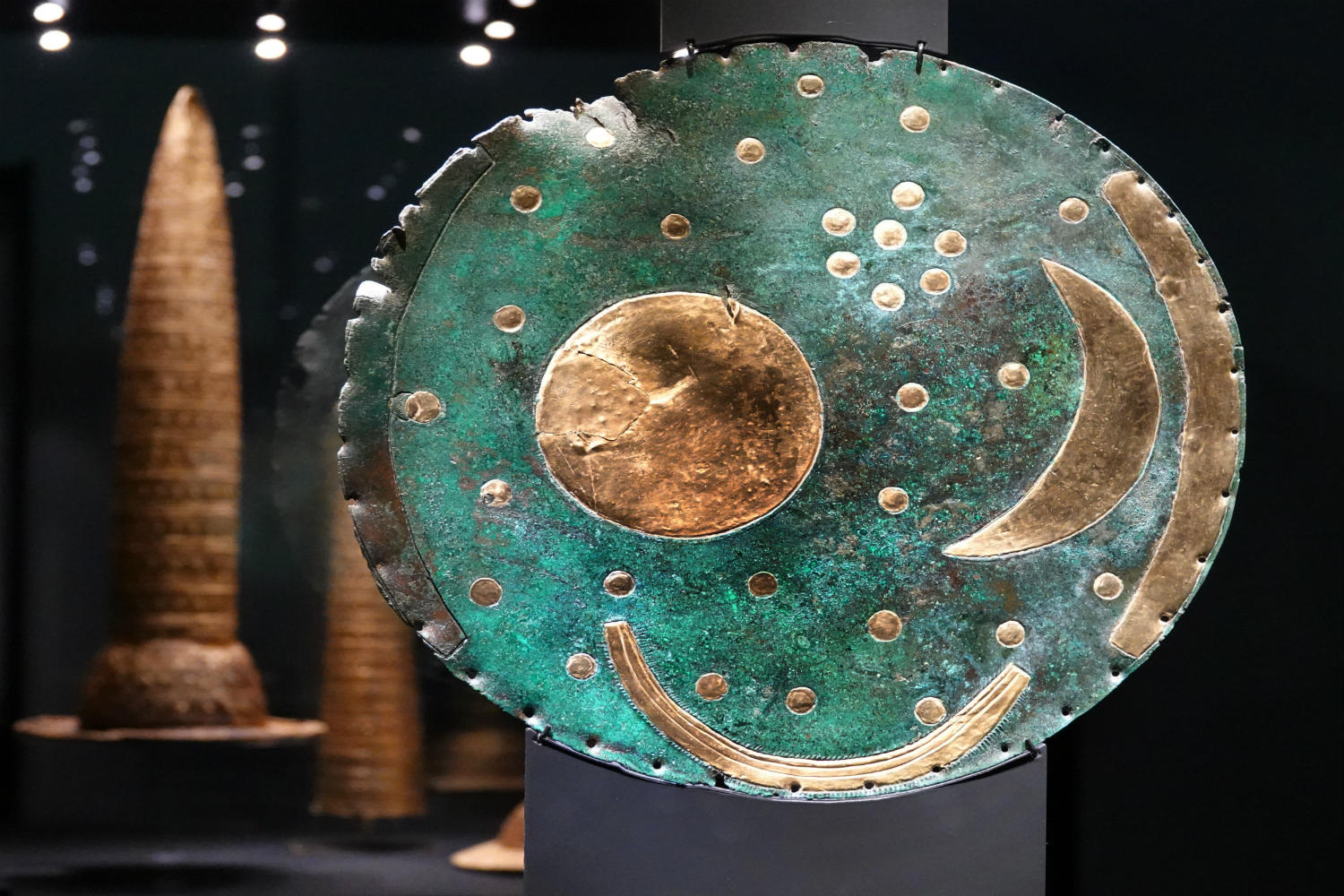
The oldest testimony of the sky is the Celestial Disc of Nebra, bronze and gold artifact found in the Mittelberg hill in Germany, considered the first man-made icon and calendar of the sky, dating back to the Bronze Age (3300 - 1200 BC). Initially the disc depicted only the group of stars of the seven Pleiades top center, the decorative stars around, and the two major stars, considered by Meller and Schlosser to be the full moon and the crescent moon, because the set of celestial bodies depicted occurred at the time just before sunset in the western sky between 10 March and October 17, the best time in agriculture for sowing and harvesting. However, the hypothesis that they are Sun and Moon remains equally valid.
According to the study of the archaeologist Adrian Gaspani, the two lateral gold bands (the one on the left has been lost) subsequently added subtend an angle of 82,7 degrees each, which measure how much the proportion of the rising and setting points of the Sun on the horizon at the latitude of the hill , in the period between the winter and summer solstice. The Disc would then draw the surrounding region with a certain fidelity, uniting heaven and earth in a perfect local chronosphere, acting as a compass and solar calendar. The later addition of the golden boat at the bottom, however, attests to the expansion of the chronosphere: it would be the myth of the solar boat, which carries the Sun through the underground waters of the underworld beyond the equator when the star sets.
De Santillana and von Dechend, in their monumental work Hamlet's mill (1969), the symbolic language of the astronomical myths of antiquity, observed by the different cultures of the world, was originally a narration of the movement of the stars, the alternation of the seasons (equinoxes and solstices) and of the ages of the world caused by the movements of our planet. A necessary language, given that for De Santillana ancient man measured time with the symbols of myth. Two temporalities in particular have marked human time: the precession of the equinoxes, a very long cycle named for this Great Year, and the zodiac wheel, which marked measurable time.

The time of the zodiac wheel is established by looking East at the constellation in which the Sun rises day by day, changing every thirty days throughout the year. Following the studies of Cumont in its The Zodiac (1919), we know that the symbols of the constellations gradually appeared on the boundary stones during the Bronze Age among the Babylonians, and were then organized by the Chaldean priests into twelve constellations on the celestial sphere. The time of the zodiac was blurred: it indicated a cycle of death and rebirth close to eternity, but it also offered more particular numbers.
After some modifications of a religious and ritual nature, the zodiacal wheel also reached the Greeks and Romans, marking a chronological cycle that measured the year, as in the liturgical calendar of Athens of the first century AD, in which the twelve signs for Cumont indicate holidays and attic months. In Rome, with the beginning of the empire, the books of hymns bore the corresponding zodiac sign above each monthly column, together with a tutelary deity. The zodiac becomes a measure of the time of the year, but every moment also has a quality. Some rulers had their birth chart engraved on monuments or coins, i.e. the position of the planets in the signs at the time of their birth, while authors such as Varro in his Res rusticae they made the zodiac correspond to agricultural time.
There is another cycle that contains the zodiac, an eternal time indicated by the Greeks with the name of aion. This was a large period of time intended as large units of life, for example a person's age, generations, epoch, century, cosmic age. Gradually it became the Latin language the time of eternity, which is partly found in the measurement of the precession of the equinoxes. Andrew Casella resumes in his studio the precession, caused by the inclination of 23 °, 5 of the terrestrial axis, for which the Earth in addition to revolving on itself and around the Sun, oscillates like a top that is about to stop. This creates the appearance that in the sky the planets move counterclockwise (from east to west) with respect to the sphere of fixed stars, and that the sphere of stars is also moving "backward" in the background, with respect to the Sun. We cannot notice this in a human life because it is an imperceptible movement and very long, which completes a complete cycle in 25765 years, taking the spring equinox as its starting point. From there it was calculated the long apparent transit of the Sun of about 2100 years in a constellation of the zodiac. The retrograde movement means that instead of following the classic zodiacal order of Aries-Taurus-Gemini, the Sun follows the reverse Aries-Pisces-Aquarius order. De Santillana and von Dechend go even further, stating that:
«Our age (0 BC - 2100 AD) is marked by the advent of Christ the Fish. Virgilio, shortly before the Year of the Lord, he greeted her with the words "a great series of centuries is born again", which gave him the strange title of prophet of Christianity. The previous age, that of Aries (2100 BC - 0 AD), had been announced by Moses who came down from Sinai "with the two horns", that is, crowned with the horns of Aries, while his disobedient flock insisted on dancing around the "golden calf", better understood as a "golden bull", the Bull (4200 BC - 2100 BC). "
Mythological figures such as the solar ox Apis, present in Egypt since 3000 BC as the Latin philosopher attests Aelian, or the two horns of Moses, which Michelangelo also takes up in his famous statue, would thus be symbolic representations of these conjunctions, which later became the common heritage of Western civilization. The precession of the equinoxes marked the great ages of the world for the ancients, and the zodiac sign of that age, with its attributes, gradually became an important cultural influence over the span of its period.
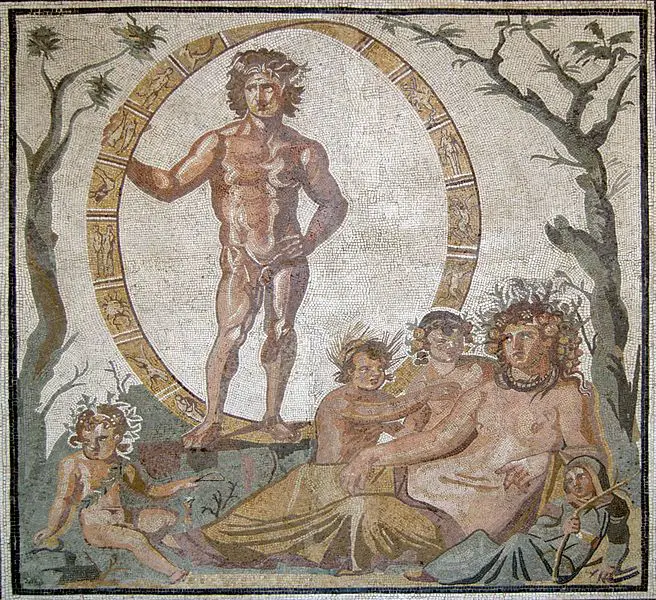
When Jung in his work Aion (1954) takes up the ages of the world, emphasizes the importance of this archetypal inheritance for the psyche of modern man. Even if today the constellations have slightly changed their position compared to two thousand years ago, for the psychoanalyst, on a collective unconscious level, humanity continues to behave over time using the zodiacal rhythms of precession without its knowledge.. For Jung, the two thousand years that have just passed fall under the Age of Pisces, an epoch marked by the Christ-Antichrist binomial, and the one we are entering is the Age of Aquarius. Nietzsche refers to this passage, he who signed himself Antichrist in his letters, when in Thus he spoke Zarathustra (1885), reads:
«You teach that there is a great year of becoming, a year beyond any great limit, which, like an hourglass, must always overturn, in order to flow and run out. "
Likewise for Jünger in his At the Wall of Time, who are "the mythical element remains alive, especially where one encounters temporal boundaries: in the case of birth and death, in wars and catastrophes of all kinds ». When great epochal cataclysms occur, such as the Great Wars of the last century, behind there is always the presence of a mythical time that manifests itself in history. Thus man acts immersed in the chronosphere of myth.
Astronomical chronospheres: traveling between times
« Is that basically time and river
they look alike:
both flow while remaining
in the exact spot from which they left. »Angelo Andreotti, "At time and place "
At the beginning of the twentieth century, Einstein cancels the vision of a single homogeneous and absolute time for the whole universe. In his special theory of relativity, time, space and matter are relative to the inertial frame of reference and the speed of movement, where the maximum limit is the speed of light (299.792.458 meters / s). It turns out that in fact light is synonymous with space and time, if I say 1 second I am saying 299.792.458 meters. Since there is no longer an equal time for everyone, Einstein-Minkowski's four-dimensional spacetime is born. In this way, particular events are taken as a reference, like pins on a canvas, each with its own portion of the past and future, plus a portion of the universe that is neither past nor future. Since light equals time, Minkowski introduced light cones.

The light cone it is a simplified scheme to give us the idea of the passing of time. Like so many communicating hourglasses, the grains of sand flow from the future (the cone at the top) to the past (the cone at the bottom), but only some of them will pass through a specific mouth. All the others will have to fall through other nearby mouths, so they will not correlate with the grains that have fallen into the other mouths. Each grain is an event, and the moment it passes through his mouth, it takes place in his present. All the grains that have passed or will pass through the mouth form a causal time series of events linked by the "world line", which marks its evolution in spacetime.
The light cone is an image that helps us to visualize time, but in space it must be considered three-dimensionally. Its circular sections are concentric spherical light waves (the light propagates in all directions) that follow each other by radiation creating a temporal order. Each sphere of light is the scene of a precise moment, and their concentric succession draws the timeline and the position in space of that particular event, similar to a pearl rosary.
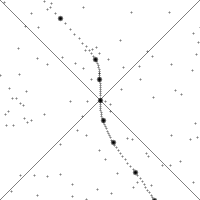
Every body lives immersed in time for the simple fact that it has mass. With the theory of general relativity, Einstein understands that the mass of a body curves spacetime around itself, and this curvature is the gravitational field. Light is bent and held if it passes near a planet, black hole, or cluster of galaxies, and so the same goes for time. Gravity dilates time. It is the gradual chronosphere of that celestial body, so the more intense the curvature, the more time is slowed down, until in the case of the event horizon of a hyper-massive body such as a black hole, it stops relative to the outside.
If with a spaceship we circumnavigated the gravitational field of a rotating black hole, without falling into the event horizon, an observer from outside would see us slowed down, and for us time would flow normally, even if we would be aging less. Furthermore, if one gravitational field is stronger than another, we would gain time over the latter. As he remembers Roberto Trotta, if we visited the Sun, we would gain 66 seconds per year relative to the Earth, and like in the film Interstellar, we could theoretically spend an hour in the gravitational field of a black hole and find that seven years have passed on Earth, even though in practice we would be crushed by gravity.

Einstein also discovers that the concept of time presupposes simultaneity. In Relativity: popular exposition (1917), having placed two identical clocks, the physicist hypothesizes «that their hands simultaneously have the same positions. In these conditions we mean by the “time” of an event the reading (position of the hands) of the one among these clocks that is in the immediate (spatial) proximity of the event in question ». Simultaneity does not exist absolutely, but only in reference to our position in space and speed of movement. Taking the example of a train passing alongside a platform, Einstein imagines that two lightning strikes fall between the platform and the train. In this case the observers on the platform, being stationary, will see the two lightning strikes falling simultaneously, but the passengers of the train, being in motion, will see the lightning closest to the train fall first, and then the farthest one. Due to simultaneity, to take Morton back:
"[...] one object regulates the time of other objects: the Moon regulates the time of the Earth in one way, the Sun in another. The seasons are a result of how the Earth's orbit interprets the Sun. The light of day and night regulate the time of the house, illuminating some of its sides and leaving others in the shade. "
But none of these events happen at the same time for everyone. Simultaneity is asymmetrical. As in the circles of Robert Delunay, simultaneity brings together the unfolding of each temporality with respect to one another, but it is the observer's point of reference (each different color) that determines the set of events that we call our present, and this changes according to the our speed and direction of movement. We take il Andromeda paradox by Roger Penrose that Roberto Paura reports in his article about time travel. Two characters from Star Trek, Captain Kirk approaching Earth from the Andromeda galaxy, and Commander Sulu leaving Earth heading for the same galaxy, would experience two different presents as they pass by in Earth's orbit. Let's say that an enemy fleet has to depart from Andromeda. For Sulu who is accelerating towards Andromeda, the departure of the fleet is a thing of the past, it has already happened. For Kirk, who is accelerating in the opposite direction of the galaxy, the fleet is in the future, that is, it has yet to leave. Their speed distorts the order in which present events happen from their point of view.

For this Carlo Rovelli, theoretical physicist of loop theory, explains in his The order of time (2017) which "Now" means nothing. If each event is enclosed in its own space-time sphere, then what we call present is not an instant valid for the whole universe, but a particular situation in our experience. Rovelli gives the example of two people on two different planets. There is no point in asking if there is a present moment between me on Earth and a person on Next b four light years away from me, because it would take light four years to get to Earth to show me what the other is doing.
The present is limited by the light. Taking up a spherical image, for Rovelli the present «It is like a bubble near us. How big is this bubble? It depends on the precision with which we determine the time. If it is nanoseconds, the present is defined only for a few meters, if it is milliseconds, the present is defined for kilometers ". Our eyes always look into the past. More than looking at the world for what it is, everything is a huge mirror reflecting how things were just before the light reached our eyes. The chronosphere that surrounds us filters time for us.
This also applies to our observation of the universe. The deeper we look at the night sky, the more we look into the past. The universe is expanding, and as Hubble confirmed in 1929, the farther the galaxies are from us, the faster they move away, with a speed proportional to their distance, equal to any point in the universe we are in. This departure is caused by the fact that the universe generates new space faster than the speed of light, so it is not us or those galaxies that move, but the space between us is expanding, cas if we were on a balloon. Our expanding region of space that moves at exactly the speed of light is called Hubble sphere, our local chronosphere with a radius of approximately 14,7 billion light years. The inside of the sphere contains all the galaxies that are moving from us slower than light, they can be observed directly, and if we traveled at superluminal speeds we could reach them. What is beyond the sphere moves faster than light and out of our reach.
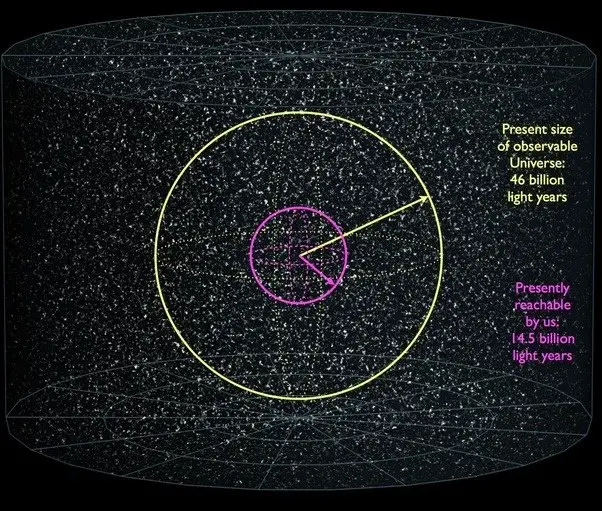
Even though the age of the universe from its origin is 13,8 billion light years, we can see galaxies at 14,7 billion light years because spacetime itself has expanded in the meantime. Furthermore, the light we observe from these galaxies is not the light they are emitting now, but from when they were closest, so the observable universe is larger than its age. Its radius is approximately 45,7 billion light years, totaling 92 billion light years in diameter. Due to the expansion of space, the light from more distant galaxies will also be slowed down, so their spectrum shifts towards red. Taking up Ian Stewart in his own The calculation of the cosmos (2016) «The farther away a galaxy is, the longer it took for its light to reach us. Its red shift Now indicates its speed of allora". We can see galaxies beyond the Hubble chronosphere as their light enters our sphere.
The artist and musician Pablos Carlos Budassi he encapsulated our entire chronospheric experience into his famous map of the universe, feeling that existing maps were inelegant. By grouping the images collected by the astronomical research team of Princeton University together with images taken by NASA's telescopes and probes, he created a circular map that encompasses the entire universe observable from Earth. From the center of our planet, distances grow exponentially up to cosmic background radiation, an immense sphere of infrared light, remnant of the Big Bang. All the universe that we can experience is here, our time cage.

68% of the universe is made up of dark energy, something we don't yet know what it is, but which is accelerating the expansion of the universe. Dark energy renders 97% of galaxies unattainable in our observable universe, far beyond the Hubble chronosphere. With any means of propulsion we could never reach it. One solution in theory would be to generate our own chronosphere by acting on the very fabric of reality. The Mexican physicist Miguel Alcubierre postulated a warp engine o warp drives. warp drives it bypasses the problem of moving in spacetime, creating a "bubble of curvature" around the spaceship, a local chronosphere on which spacetime glides. Instead of moving in spacetime, we make spacetime move around us, contracting it in front of our bubble and expanding it behind, like a pump. Unfortunately at the moment the warp engine is beyond our reach, but it still offers an important research stimulus. To move in time, you need to master time.
Thanks to Daniele Gambetta for the mathematical consultations.

4 comments on “We do not live in time, but in "chronospheres""